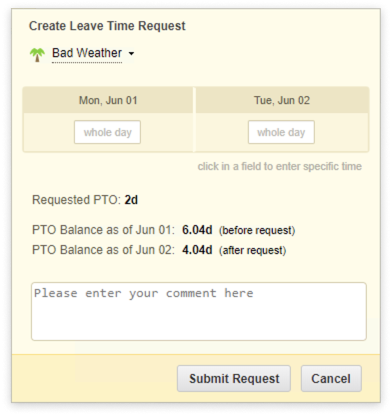No one likes bad weather. As for extreme climatic conditions, besides being unpleasant to experience, they are often hazardous to our health and may cause serious damages to the environments where we live.
Businesses need to know how to minimize the threats that any kind of severe weather poses to their most valuable corporate asset – the workforce. A well-developed inclement weather policy can be of tremendous help in this regard.
In the present guide, you will find how to develop your own highly effective policy covering everything from the definition of inclement weather that applies to your specific case to the matters of emergency communication.
Define Inclement Weather
To make things clear, define the term “inclement weather” at the beginning of your policy.
In general, inclement weather means abnormal climatic conditions – including flooding rains, snow or dust storms, extremely high or low temperatures – that make it unsafe to stay outside or travel. Such weather conditions also frequently cause the closure of schools and daycare facilities, as well as the disruption of transit services and electricity outages. That is to say, they are pretty intense in severity.
Inclement weather scenarios vary from one region to another. Moreover, some climatic conditions may be very dangerous to employee health in one occupational context but of absolutely no harm in another. For instance, linemen and outdoors construction workers cannot perform their jobs safely in gale winds, whereas office employees can. Thus, it makes perfect sense to specify in the policy which types of inclement weather apply to your particular business situation.
If you don’t find it necessary to be so detailed and subjective in your definition of adverse weather, just follow the guidelines provided by your state officials and require employees to stay home merely when the government imposes travel restrictions.

Take into Account Federal and Local Inclement Weather Regulations
Check what the federal and local officials say about severe weather and occupational safety.
For example, if your business is based in the United States, you should get familiar with the provisions of the Fair Labor Standards Act (FLSA). They indicate how to deal with employee pay when your business is temporarily shut down due to inclement weather.
Additionally, explore the guidelines by the Occupational Safety and Health Administration (OSHA). They outline standards for optimal workplace temperatures and encourage employers to minimize the risks of employee exposure to either excess heat or extreme cold.
It’s quite easy to make a logical connection between adverse weather and workplace temperatures, especially when your employees do their jobs outdoors. So, you should pay attention to how weather conditions affect the safety of employees both within the workspace and on the way to work.
Allocate Decision Making Roles
As the owner and a key manager of the company, you will likely be the one to decide when and for how long the workplace is to be closed. Nevertheless, it would be helpful to consider who else will have the authority to determine if the business ought to be shut down due to bad weather while you’re away.
Allocate roles to competent employees and expound relevant responsibilities in the inclement weather policy to reduce confusion in this regard, protect your business and minimize risks to personnel.
Outline Employer and Employee Responsibilities
Respect for contract obligations is at the core of positive employer-employee relationships. Thus, to secure long-term productive collaboration, it is necessary to identify which of the parties’ regular duties and rights will be subject to changes due to inclement weather conditions and which will remain the same.
Employer Responsibilities
As an employer, you are legally obliged to provide your subordinates with safe working conditions and eliminate any harm to their health in the course of work. Since commute is an essential part of the workday, if you demand your employees to arrive at the workplace no matter how hazardous the weather is, you risk not only their health but also a lawsuit because you may be deemed at fault in an accident that can take place.
Therefore, even when government officials don’t issue travel restrictions on a bad weather day, evaluate the situation more thoroughly before requiring your workers to attend the workplace. In case one’s commute seems to be particularly complicated due to severe climatic events at the moment, it’s in your own interest to let them stay home safely.

Another responsibility employers usually have as part of the inclement weather policy is notifying subordinates about any changes in organizational schedules promptly. You need to develop a proper emergency communication plan for this purpose and inform your employees on how they will be alerted about potential business closures or delayed openings. By doing so, you’ll set appropriate expectations and increase communication effectiveness.
Responsibilities of Essential vs. Non-Essential Workers
Complete workplace closure is not an option sometimes. Regardless of how terrible the weather is, businesses still need to sustain services and operations upon which they are built and which define the well-being of their staff members and other stakeholders.
For this reason, you need to identify processes and activities that must be covered even during extreme climatic conditions: IT network maintenance, payroll, customer support, etc. After this, you will easily distinguish between essential and non-essential employees or, in other words, those who play a critical role in maintaining business continuity and those whose part in this is somewhat less important.

Such a distinction is necessary since the two groups of workers may have a completely different set of duties in the inclement weather context – some can be allowed to stay home, but the presence of others at the workplace is vital.
All in all, you may require essential employees to attend work even throughout a bad weather period (whenever such a requirement is reasonable enough and not too risky). If you plan to do so, you should specify whether their regular terms of employment – work hours, job duties, compensation – will be any different during this time. Note that by offering extra rewards and benefits to essential workers and recognizing their contributions in any other way, you minimize the risk of decreased morale and negative perceptions that can ruin one’s job satisfaction and commitment, leading to increased staff turnover.
As for your non-essential employees, when deciding on what they are supposed to do during the periods of adverse weather, you have at least three options to choose from:
-
Let them stay home and enjoy a spontaneous day off,
-
Ask them to make up the lost time later,
-
Demand them to work from home in case the nature of your business activities allows for that.
When requesting your team to work remotely, you need to consider employees’ technological capacities first and support them in the arrangement of the telecommuting process in advance. Also, assume designing a separate policy addressing all legal and performance-related issues that may arise when your team is working from home. With its help, you will maximize remote employees’ productivity – both on bad and good weather days – and minimize organizational risks.
Think About Payment Requirements
Your inclement weather policy must cover the matters of pay in relation to all relevant employee groups: essential and non-essential, part-time and full-time, salaried and hourly (aka exempt and non-exemp) workers.
Speaking of exempt employees, they are legally entitled to a full day’s pay when their employer decides to close the workplace due to adverse weather conditions.
However, if a person belonging to this group of employees voluntarily chooses not to come to work on a lousy weather day, you have all the right not to pay them.
Note that in case an exempt employee comes to the office late or wants to leave earlier due to severe weather conditions, you may deduct the lost time from their PTO balance, but you will have to compensate them for a full day of work nevertheless.
To manage PTO in such situations, consider utilizing a high-quality leave management app, such as actiPLANS – it allows creating custom time off categories and significantly facilitates the process of leave requests submission and approval.

As for non-exempt employees, the FLSA requires remunerating them only for the number of hours actually worked. It means that if you decide to close the company for a day or two, you won’t have to compensate hourly workers during that period at all since they won’t do any job.
However, some states mandate employers to give minimum wages to non-exempt workers in case they report for duty as scheduled. In other words, if an employee is scheduled to work for three or more hours and comes to the workplace on time, but then you decide to close the workplace earlier due to adverse weather, you will have to pay this employee for at least three hours even if they worked less.
Variations of such reporting pay regulations are currently enacted in:
-
California,
-
New York,
-
New Jersey,
-
Massachusetts,
-
Connecticut,
-
Oregon,
-
Washington D.C.,
-
New Hampshire,
-
Rhode Island.
Other Things to Consider
Here are some more questions you can ask yourself in order to enhance the inclement weather policy and make it as comprehensive as possible:
-
Which options will be offered to employees with children whenever the workplace isn’t closed but schools and daycare facilities are?
-
Which methods should workers utilize to notify you or other managers about lateness or inability to come to work because of bad weather?
-
What kind of penalties will apply in case of noncompliance with the inclement weather policy rules?
-
How will you educate your subordinates on their level of responsibility and associated duties?
Don’t be afraid to cover an extended number of issues in your policy and address as many of your concerns in the document as you believe is right. Eventually, it will only increase its practical value and provide a higher degree of protection to both your subordinates and yourself.
For more effortless and streamlined management of employee absence during bad weather – and throughout other times, regardless of how extraordinary or ordinary they may be – implement actiPLANS. With its support, you’ll be able to:
-
Introduce greater clarity into the matters of employee availability at the workplace,
-
Increase the accuracy of PTO tracking,
-
Raise colleagues’ awareness of changes in personal schedules by leaving comments.
Today you have a chance to get hold of these and many other advantages of actiPLANS for free! Sign up for a trial and use the app at no cost for 30 days straight.




